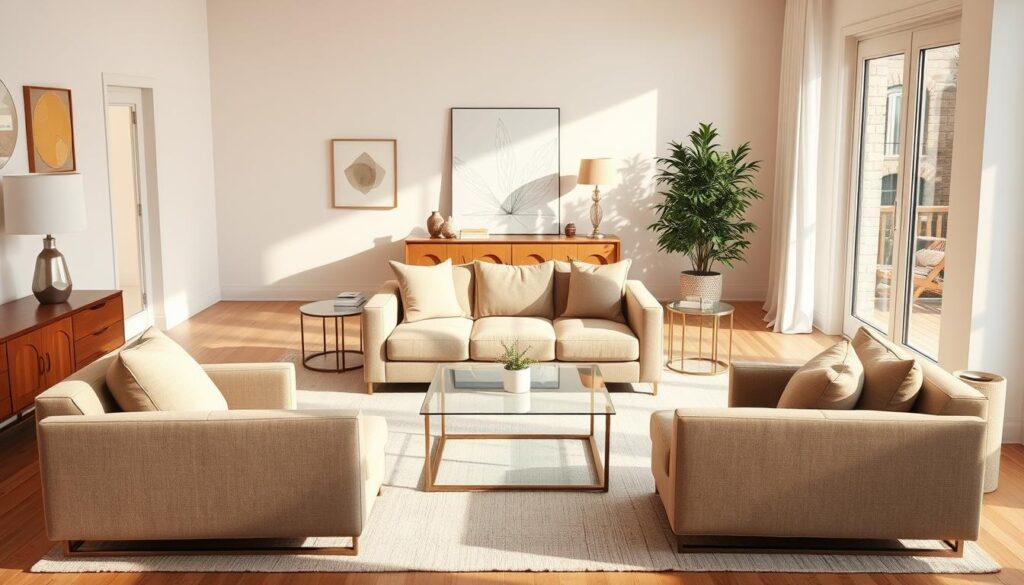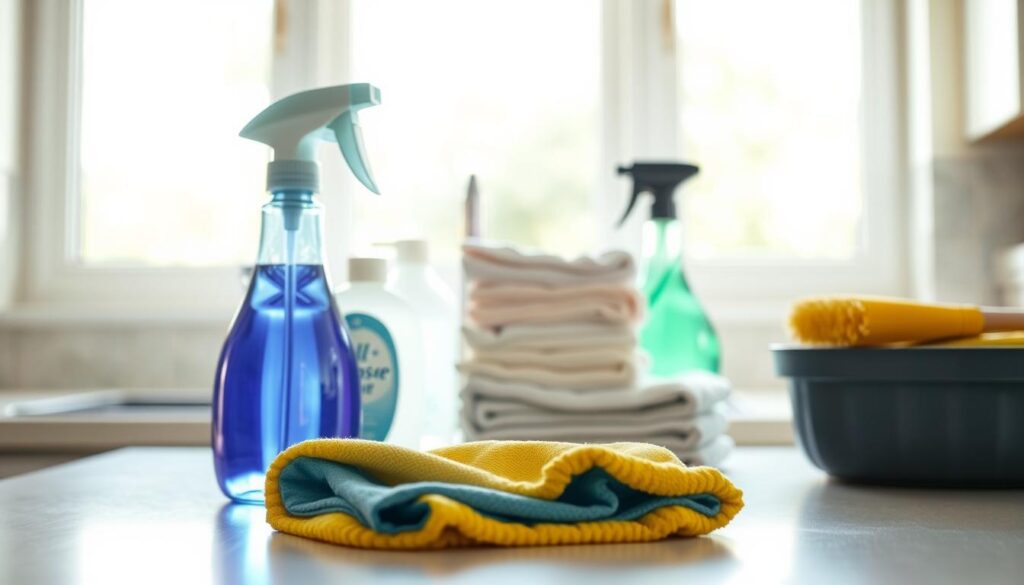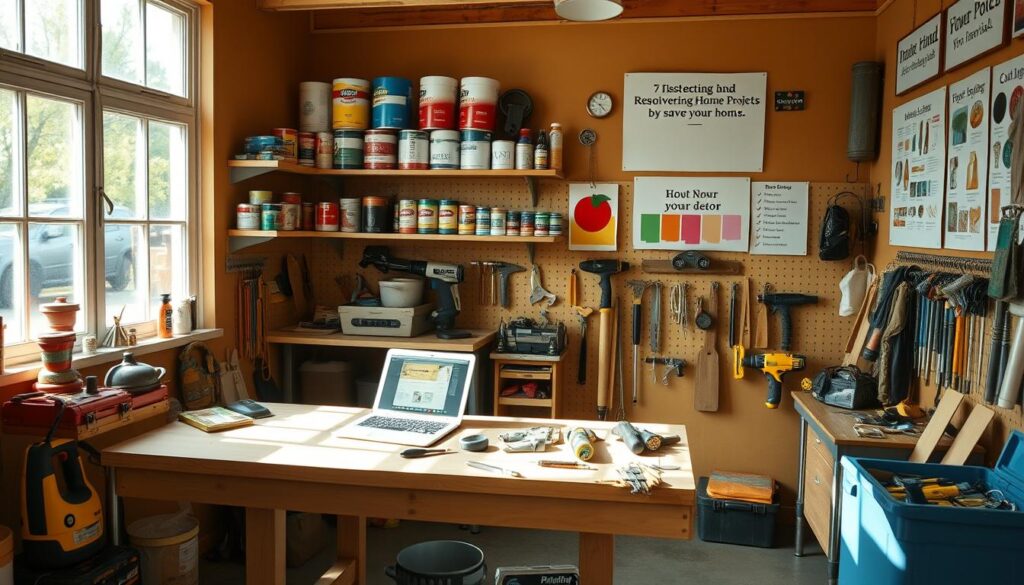Did you know a cluttered and dull living space can harm your mental health? Refreshing your dingy home interior might seem hard, but it’s doable. We’ll share our best tips to make your space welcoming and enjoyable.
We’ll talk about why your space might feel dull and how to make it your own. For more DIY interior design ideas, check out our resources to revamp your home.
Key Takeaways
- Understand the causes of a dull interior
- Learn how to personalize your space effectively
- Discover simple DIY projects for home improvement
- Find out how to maintain your newly revived interior
- Explore creative ways to enhance your living space
Understanding the Causes of a Dingy Home Interior
To make a home’s interior look brighter, we need to know why it’s dull. There are many reasons why a home might look dingy. Knowing these reasons helps us find the best ways to fix it.
Poor Lighting Choices
Lighting is very important for how we see our homes. Poor lighting choices can make rooms feel dark and unwelcoming. This can happen if there’s not enough natural light or if the wrong light fixtures and bulbs are used.
For example, using warm-toned bulbs where we need bright light can cause eye strain. It can also make the room look dingy.
Outdated Color Schemes
Using old color schemes can make a home look outdated and tired. Colors that were once popular can now make the interior look dingy. Experts say that some paint colors can make a house look dingy.
Changing to newer, fresher colors can make a big difference. It can help brighten up the space and make it look more modern.
Lack of Maintenance
A lack of regular maintenance can cause dirt and grime to build up. This makes a home’s interior look even dingier. Dust on surfaces, dirty windows, and neglected corners all affect how a home looks.
Keeping a home clean and well-maintained is key. It helps it stay looking its best.
Assessing Your Current Interior
To make your space beautiful and useful, start by checking your current interior. This first step is key for a great room makeover. It will help guide your choices in the home decor project.
Room-by-Room Evaluation
Walk through your home and check each room. Note the layout, furniture condition, and feel. Think about each room’s purpose and how you use it. This room-by-room evaluation will show you what’s good and what needs work.
Identifying Problem Areas
As you check each room, find areas that need fixing. Look for clutter, old furniture, and bad lighting. These issues can make a room look dull and unfriendly. Spotting these problems lets you start thinking of fixes.
Gathering Inspiration
Finding inspiration is key in home decor. Check out home decor magazines, social media like Pinterest or Instagram, and home decor websites. Make a vision board or a folder on your phone for ideas. This helps you see your space’s potential and guides your makeover choices.
By doing these steps, you’re on your way to a detailed plan for your room makeover. The aim is to turn your space into a beautiful, functional area that shows your style.
Choosing the Right Color Palette
The right color palette can make your home feel fresher and more welcoming. When we want to make our home look better, picking the right colors is key.
Warm vs. Cool Colors
Colors fall into two main groups: warm and cool tones. Warm colors like oranges, reds, and yellows make spaces cozy and inviting. They’re great for living rooms and kitchens.
Cool colors such as blues, greens, and purples calm the mind. They’re perfect for bedrooms and bathrooms.
Accent Walls
Accent walls are a smart way to add color without overwhelming a room. Painting one wall in a bold color creates a focal point. It draws the eye and adds interest.
Paint vs. Wallpaper
Choosing between fresh paint and wallpaper depends on several things. Paint is easy to change and affordable. Wallpaper, with its patterns and textures, adds depth and character.
The right lighting ideas can make either choice stand out. It makes the space feel more alive and vibrant.
Whether to use paint or wallpaper depends on your style and the room’s purpose. By thinking about these and trying different options, you can find the best way to refresh your home.
Enhancing Natural Light
Natural light can change how we feel in our homes. It makes them feel bigger and more welcoming. By improving the natural light, we can make our homes brighter and more inviting.
One easy way to start is by changing our window treatments. The right window coverings can greatly affect how much light we get.
Window Treatments
Choosing the right window treatments is key for more natural light. Sheer curtains, blinds, or shades can control the light. For example, sheer curtains filter the light but still let it in.
Mirrors and Reflective Surfaces
Using mirrors and reflective surfaces is another smart move. Mirrors placed opposite windows reflect light, making rooms brighter. Also, using shiny surfaces like metallic or glass can boost the light effect.
| Technique | Description | Effect |
|---|---|---|
| Mirrors Opposite Windows | Reflects natural light into the room | Brightens the space |
| Reflective Surfaces | Amplifies natural light with metallic or glass accents | Enhances brightness and ambiance |
Skylights and Open Spaces
For a bigger change, think about skylights or open spaces. Skylights bring light from above, lighting up dark areas. Open floor plans spread light evenly, cutting down on the need for artificial light.
By using these methods, we can really brighten up our homes. More natural light makes our spaces feel larger and more welcoming. It also improves our health and happiness.
Flooring Solutions for a Fresh Look
Updating your flooring is a simple yet effective way to revitalize your home’s interior. When considering a furniture update or a broader home decor refresh, the flooring is a crucial element that can tie the whole space together.
Before diving into the specifics, it’s essential to assess the current state of your floors and determine the best course of action. Whether you’re dealing with outdated carpet, worn-out hardwood, or perhaps tile that needs a facelift, understanding your options is key.
Carpet vs. Hard Flooring
The debate between carpet and hard flooring is ongoing, with each having its pros and cons. Carpet can add warmth and comfort underfoot, making it an excellent choice for bedrooms and living areas. On the other hand, hard flooring, including hardwood, tile, and laminate, offers durability and ease of maintenance, making it suitable for high-traffic areas.
| Flooring Type | Pros | Cons |
|---|---|---|
| Carpet | Warmth, Comfort, Noise Reduction | Maintenance, Allergens, Limited Durability |
| Hard Flooring | Durability, Easy Maintenance, Versatility | Coldness, Hardness, Potential for Scratches |
Area Rugs as Decor
Area rugs can serve as a decorative element, adding color, texture, and warmth to a room. They can also help define different spaces within an open-plan area. When choosing an area rug, consider the existing color palette and furniture to ensure it complements your home decor.
“A well-placed area rug can transform a room by adding a layer of depth and visual interest.”
Restoring Wood or Tile Floors
If you have existing wood or tile floors, restoring them can be a cost-effective way to achieve a fresh look. For wood floors, this might involve sanding and refinishing, while tile floors might require regrouting or replacing damaged tiles.
Restoring your floors not only enhances their appearance but also extends their lifespan. It’s a worthwhile investment that can significantly impact your home’s overall aesthetic, making it look modern and inviting when paired with a thoughtful furniture update.
In conclusion, updating your flooring is a significant step in refreshing your home’s decor. By considering the type of flooring, using area rugs effectively, and restoring existing floors, you can achieve a look that is both modern and inviting.
Furniture Arrangements for Clarity
The way we arrange our furniture greatly affects our living space. A well-arranged room looks better and works better. We’ll look at how to make our furniture arrangements clear and effective.
Decluttering Tips
Before we arrange furniture, we need to declutter. Getting rid of things we don’t need makes our space feel bigger. Here are some tips for decluttering:
- Sort items into categories (keep, donate, sell, throw away).
- Focus on one area at a time to avoid feeling overwhelmed.
- Consider the 80/20 rule: 80% of the time, we use 20% of our belongings.
Efficient Layout Ideas
An efficient layout is key for a functional living area. Here are some ideas to consider:
- Create a traffic lane: Ensure there’s a clear path through the room.
- Use a focal point: Arrange furniture around a central feature, like a fireplace.
- Consider the room’s purpose: Different activities require different layouts.
Multi-Functional Furniture
Using multi-functional furniture can make our space feel bigger and more organized. Examples include:
- Storage ottomans.
- Sofa beds.
- Drop-leaf tables.

Here’s a comparison of different furniture types based on functionality and space requirements:
| Furniture Type | Functionality | Space Requirement |
|---|---|---|
| Sofa Bed | High | Medium |
| Storage Ottoman | Medium | Low |
| Drop-Leaf Table | High | Low |
By following these tips and ideas, we can create a more organized, functional, and beautiful living space. It will reflect good interior design and useful cleaning tips to keep our home looking great.
Incorporating Accessories and Decor
After painting, we focus on adding accessories and decor. These elements make our home truly ours. By choosing and placing them wisely, we can make our space inviting and personal.
Art and Wall Hangings
Art and wall hangings bring personality to our rooms. They can be paintings, prints, photographs, or sculptures. For more ideas, check out expert decorating tips.
Indoor Plants for Life
Indoor plants purify the air and add life to our space. They come in many shapes and sizes. Whether you like succulents or greenery, there’s a plant for every style.
Decorative Pillows and Throws
Decorative pillows and throws add color and texture. They match our fresh paint and enhance our space’s look. Mixing patterns and textures creates a layered, interesting look.
By adding these elements thoughtfully, we create a welcoming home. The goal is to balance them for a harmonious atmosphere.
Utilizing Cleaning and Maintenance Techniques
To keep our homes looking their best, regular cleaning and maintenance are key. A well-maintained home is not just more appealing. It also helps us live healthier. By following effective cleaning routines, we can stop dirt and grime from making our homes look dingy.
Effective Daily Routines
Having a regular cleaning schedule makes a big difference. Simple tasks like dusting, vacuuming, and wiping down surfaces can be done daily or weekly. For example, spending just 10 minutes a day tidying up can stop clutter from piling up.
Seasonal Deep Cleaning Strategies
While daily routines are important, we also need seasonal deep cleaning. This helps us tackle harder tasks like cleaning the oven, dusting ceiling fans, and organizing closets. By breaking these tasks into smaller parts and doing them seasonally, we can keep our homes fresh and clean.
Here’s a sample seasonal deep cleaning schedule:
| Season | Tasks |
|---|---|
| Spring | Clean windows, dust ceiling fans, organize closets |
| Summer | Deep clean the kitchen, clean out the garage, wash curtains |
| Autumn | Clean out the gutters, rake leaves, prepare the home for winter |
| Winter | Inspect and clean the fireplace, check for drafts, maintain heating systems |
Knowing When to Seek Professional Help
There are times when we need professional cleaning services. This might be after a big renovation or when we have tough stains and dirt. Knowing when to ask for help can save us time and ensure our home is thoroughly cleaned.

By following these cleaning tips and maintenance techniques, we can keep our homes looking fresh and clean. Regular cleaning, seasonal deep cleaning, and knowing when to seek professional help are all key to maintaining a welcoming and healthy home.
Personalizing Your Space
As we near the end of our journey to revive our dingy home interior, it’s essential to make our space truly ours. Personalizing our home is what makes it feel like a haven, reflecting our personality and style.
Making it Personal
Incorporating family heirlooms and personal art into our home decor can add emotional value and character. These unique pieces tell our story and create a sense of warmth and belonging.
Adding a Unique Touch
Engaging in interior design DIY projects can introduce a unique touch, making our space stand out. From custom wall art to handmade decorative items, these projects allow us to express our creativity.
Tying it All Together
Creating a cohesive theme by tying together different elements can result in a harmonious and inviting atmosphere. By balancing our personal touches with our overall home decor and interior design, we can create a space that feels truly ours.


